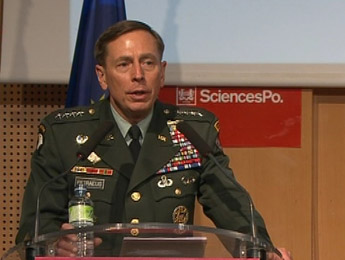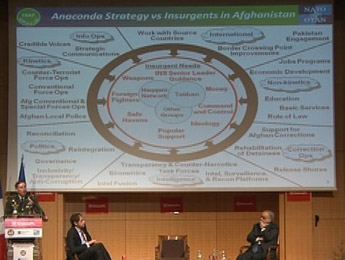‘Professor of War’ Petraeus Rolls Into Town, Armed With PowerPoint
Gen. David Petraeus, the most important US commander, the man with the plan in Afghanistan, walks into the room dressed not in combat fatigues, but in his “Pennsylvania Avenue garb” - an official olive green uniform emblazoned with more medals, ribbons and military insignia than I can count.

The top US and NATO commander in Afghanistan is in town for meetings with French military and political officials that have been closed to the press. But today, “the professor of war” as he is called, is addressing students at the elite, Paris-based SciencesPo University.
And professorial Petraeus certainly is, kicking off his address with a tribute to his Princeton University thesis advisor.
He follows that up with a story of a wily rabbit that goes like this: A rabbit sits near a cave scribbling in his notebook.
“What are you doing?” asks a fox.
‘I’m writing my thesis, which contends that rabbits are fierce fighters and can easily kill a fox.’
“Do you have hard data to prove this?” asks the fox.
‘Step into my cave,’ says the rabbit.
Minutes later, the rabbit emerges with a fox fur hat.
The process is repeated with a wolf and a grizzly bear until a wise owl flies into the mystery cave and discovers the rabbit seated between a ferocious tiger’s paws.
Here’s the moral: “It doesn’t matter how stupid your thesis is as long as you have the right advisor,” Petraeus ends the anecdote to raucous audience laughter.
Advisors and aides – especially press aides – are critical to commanders today.
The last time Petraeus’ predecessor, Gen. Stanley McChrystal, was in Paris, his aides infamously blabbed to a Rolling Stones reporter, telling him, among other things, that Paris was “the most anti-McChrystal city”.
That, of course cost McChrystal his job.
This time, the top US commander in Afghanistan is pitch-perfect. He thanks French troops in Afghanistan for their contributions in the Kapisa and Sarobi districts. He discourses about building the momentum in the Afghan counterinsurgency effort and he welcomes the outcome of last week’s NATO summit in Lisbon.
Death by PowerPoint
But when he rolls out his PowerPoint presentation, it becomes a bit too professorial to bear.
We’ve been through this war by PowerPoint rigmarole before. The US military infatuation with this software is so notorious, that when confronted with a particularly dense slideshow, McChrystal once apparently quipped, “When we understand that slide, we’ll have won the war.”
But Petraeus is not one to quit – whether it’s Taliban threats, Congressional grillings, or yes, PowerPoint overload.

Strategic military terms roll in thick and fast. The current mission in Afghanistan is not just “kinetic” (involving international and Afghan forces), but “non-kinetic” (development projects such as employment building and poverty eradication) as well.
As the slides detailing what Petraeus calls the “Anaconda strategy” get denser, with more colors and more arrows, PowerPoint stupor sets in.
Kinetics, non-kinetics and a rabbit in a hat
But the audience wakes up at question time, when students and professors are allowed to grill Petraeus.
When asked about Pakistan’s trustworthiness as a counterinsurgency partner and whether US President Barack Obama’s recent visit to India has negatively impacted Islamabad, Petraeus expresses optimism for a broad regional partnership.
Noting Russian cooperation with NATO’s Afghan mission, Petraeus says he hopes “the so-called New Great Game could give way to a broad partnership shared by common objectives of Afghanistan’s neighboring states to oppose extremism and the narcotics industry.”
A little more grilling – this time on the feasibility of the 2014 transition deadline, (which Petraeus calls “sensible and reasonable”) – and the session with America’s top military commander is over.
The general has a plane to catch in an hour, the disappointed press posse is informed.
Address over, I ask Swann Bommier, a 23-year-old SciencesPo student, how was the talk.

He shrugs. “He said nothing brand new. The rabbit anecdote was fun. But the PowerPoint presentation did not impress,” says the French student.
His friend, 28-year-old Mike Asplet from New Zealand, is a little more forthcoming.
“The most striking thing for me is the enormity of the task,” says Asplet. “They’re doing everything. The forces are not just kinetic, they’re doing social development, creating jobs, infrastructure, everything.”
“Non-kinetics?” I ask.
‘Yeah, non-kinetics,’ Asplet replies.
At least we’re got our jargon right. Thank you PowerPoint.




5 Comments
Post new comment